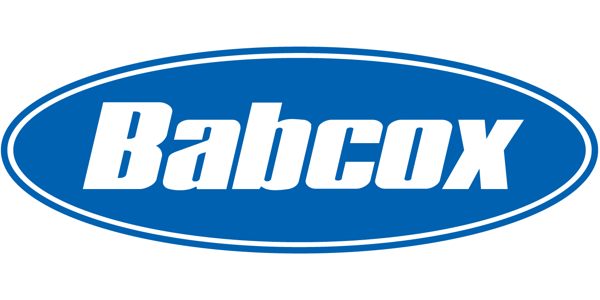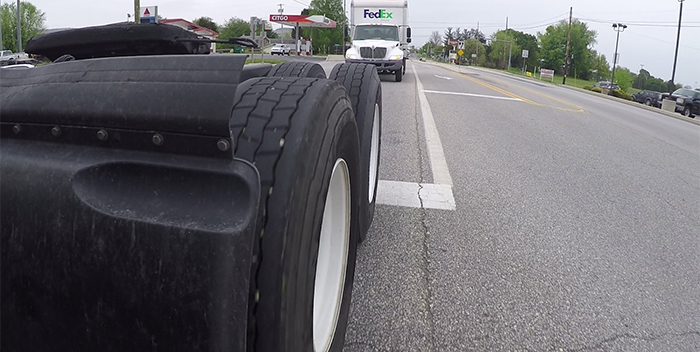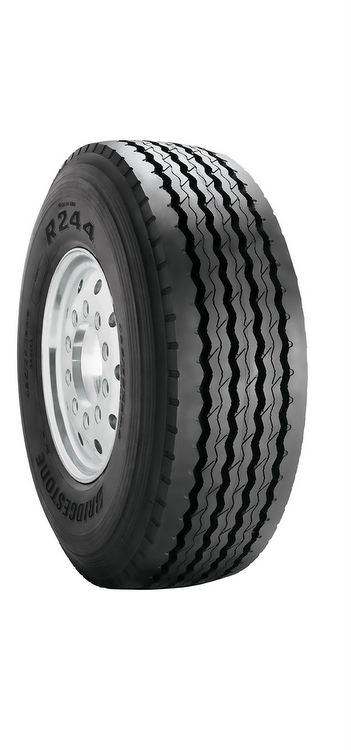Roofs and floors are key factors to consider when specifying trailers
It’s easy to overlook the complexities of trailer designs because, when properly designed and specified, they perform without incident. But, those seemingly plain van bodies offer more than meets the eye – especially when it comes to floors and roofs.
Standards and options
Van trailer floors and roof standard and options are two areas in which good designs and technology provide value-added choices for fleets. According to Vanguard Trailer, the company sets the standards for all specifications to ensure that vans meet the specified ratings for each trailer design. While there is a safety factor beyond the rating, exceeding the load rating can void Vanguard’s warranty.
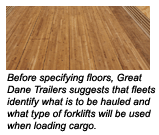
For Vanguard, the standard roof sheet is aluminum. Where interior light is desirable inside city delivery trailers, fiberglass or thermoplastic roof sheets may be installed. However, aluminum is the more durable option.
Roof bows, which have various configurations or shapes, can be steel, galvanized steel or aluminum, depending on load ratings and roof bow spacing. Anti-snag designs minimize damage to cargo that encounters a roof bow. Vanguard is standard on 1-in. deep, hot-dipped galvanized steel, anti-snag roof bows on 24-in. centers.
In applications in which loads may come in contact with roof bows during forklift loading and unloading, a ceiling liner or ceiling scuff plate (running lengthwise, protecting both the cargo and the roof bows) is advisable. Another requirement for special roof bows are applications in which cargo, such as garments or meat in a refrigerated trailer, is hung from the roof bows in transit.
Vanguard uses a two-part, heat-cured, adhesive to bond the roof bows to the roof sheet prior to installation. This further strengthens the roof system and allows a visual inspection of the bond before installation. The joint of the roof to the top side rail is very important. The roof bows are securely joined to both top side rails with 0.25-in., high-strength steel Huck fasteners. Two layers of foam tape are used to ‘double seal’ the roof sheet joint to prevent moisture intrusion.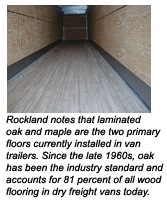
Additionally, an extruded aluminum roof cap is positioned to protect from tree limb damage and dissipate the compression stresses of the rivets securing the roof sheet to the top side rails. Roof sheet rivets are installed on 1.5- to 2-in. centers.
According to Vanguard, trailer floor systems, composed of a number of factors, all contribute to the load capability and longevity of the floor. Crossmembers, or floor sills, are fastened at each end to the bottom side rails. Crossmembers can be made of various tensile strength steel or extruded or formed aluminum. Aluminum crossmembers are used to save weight in certain applications.
Vanguard uses 4-in. deep I-beam crossmembers of 80,000-psi minimum yield that are wax-coated to seal out moisture. The wax coating is forgiving, and even self-healing, after being struck by rocks or road debris. Crossmembers are securely fastened to the bottom side rails by four Huck fasteners at each end. Vanguard’s standard crossmembers spacing is on 12-in. centers.
The life and serviceability of freight van floors depend on the type of wood used or the configuration of extruded aluminum. Vanguard uses 1 3/8-in. non-laminated, hardwood full-width or a combination of extruded aluminum to reduce weight, with two or more wood planks for use as “nailers.” Floor boards are pre-undercoated and securely fastened with three self-tapping floor screws to each crossmember and on alternating sides of the crossmember webs.
It is important that trailer designers know the intended load and placement to produce trailers with optimum strength-to-weight ratios, the trailer builder says. Knowing if the loads will be concentrated or fully distributed throughout the floor is necessary to arrive at the right crossmember spacing and floor material strength.
Floor options also include rear floor protection in the form of threshold plates, extra crossmembers or other types of protection from fork lifts entering the trailer fully loaded and when not on the same level. Load securement to the floor in the form of “D” rings or recessed chain tie downs can be incorporated to meet customer requirements.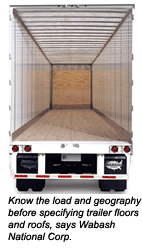
Special floor-type installations are possible. Self-unloading floors, such as a Keith Walking floor system, or even recessed rollers that are air actuated to assist moving cargo, are two examples.
Basic considerations
When specifying roofs on dry vans, there are three basic areas to consider, Great Dane Trailer says. First is the type of roof. The two options it offers are aluminum or translucent fiberglass. The trailer maker says that many customers prefer the translucent, since it provides more light into the trailer, which should translate into less interior damage. The idea is that, if forklift operators can see better, they are less likely to have a hard impact with the sidewalls or front wall. If the choice is translucent, customers typically like to upgrade the specification to the Kemlite ETR roof. This product has extra reinforcements that reduce the chance of a small puncture turning into a large tear.
According to Great Dane, many customers prefer the standard aluminum roof because it is less likely to be punctured. Some customers have temperature-sensitive dry freight, and the aluminum roof will maintain a slightly lower temperature.
The second area of the roof Great Dane focuses on is roof bow spacing. The standard, 24-in. center spacing works for the vast majority of its customers’ applications, the company says. However, there are occasions where Great Dane changes to tighter roof bow centers based on customer preferences. For example, applications that require tighter spacing are typically heavy-hauls or heavy-snow loads. In addition, roof bows are typically made of galvanized steel but can be changed to aluminum for weight-sensitive operations.
Great Dane notes that the third area of consideration when specifying roofs is the possibility of damage to the roof bows. If the customer were constantly damaging the bows, the trailer maker would add a 0.25-in. plywood ceiling liner to protect them. The ceiling liner can be full width in the center 48-in. or two rows of plywood 24-in. wide, centered on each side of the trailer.
When specifying dry van floors, Great Dane suggests it is important to know what the haul is and what type of forklifts are used when loading cargo. The standard 1.38-in., laminated hardwood floor works fine for most applications. However, trailers that are used in dedicated heavy-hauls should have upgraded floor systems.
There are several ways to accomplish this. One is to change the crossmember spacing from 12-in. to 8-in. centers. Another is to change the floor thickness from 1.38 in. to 1.50 in. Or, a composite hardwood floor could be spec’ed. These floors incorporate fiberglass into the bottom side and can provide a higher floor rating without the weight increase that you would get by changing the crossmember spacing. Aluminum floors are also sometimes specified for weight reasons.
Identify needs
Wabash National Corp. notes there are several factors that must be considered when specifying trailer floors and roofs. First, fleets should consider type of freight and geography. When it comes to roof systems, fleet managers should work with OEMs to determine the appropriate type of roof material and roof bow spacing for structural support. For example:
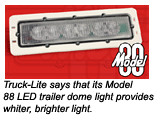
• Translucent roofs can provide a great deal of interior lighting for loading and unloading. However, in warmer climates, they can create a ‘greenhouse’ effect, in which the trailer interior gets very warm.
• If the fleet operates in an area in which heavy snow loads are common, additional roof bows might be necessary. An aluminum roof sheet tends to perform well in this type of environment, as well.
• Roof bow design also is an important consideration. If the fleet specializes in applications in which freight frequently impacts the ceiling (such as automotive parts hauls), anti-snag roof bows and interior ceiling liners are good ideas.
• Roof sheet maintenance is another factor. Damage resistance and repair methods will vary, depending on the roof material selected.
When it comes to floor systems, fleet managers should work with manufacturers to ensure that the floor is properly designed for specific applications. Type of freight, load cycles, loading environment, floor capacity and safety must all be taken into consideration. As a load cycle example, general-purpose trailers normally do not experience a great deal of heavy forklift loading. Loading the trailer once a week is quite common. However, dedicated, heavy forklift loading could include a four-times-per day load cycle. This is 20 times the number of damaging load cycles, which can mean a shorter floor life cycle if not specified properly.
In general freight applications, dry van floors with high load ratings will provide the best performance and longest life. For example, Wabash National’s standard floor system features full 1 3/8–in. oak floor boards and bolted crossmember connections to provide 20,000 lbs. working load.
Because of their low weight and high capacity, composite floors work well in heavy-load/high-cycle applications in which the trailer is loaded five or more times per week.
In refrigerated van applications, a white fiberglass material, such as SolarGuard roof, performs well, the company said. It reflects UV rays and prevents them from heating the trailer roof surface. This helps to maintain a constant interior temperature, reducing reefer unit run time and fuel costs.
Some fleets in the Pacific Northwest will specify aluminum floors in their dry freight vans because of rain and high moisture in the region. Wood floors tend to deteriorate over the years in this type of environment. Some woods tend to resist this problem better than others.
Flooring material
According to Prolam, the most important consideration when choosing a trailer floor is selecting the right flooring manufacturer. Serious flooring manufacturers have a well-documented quality control system in each step of their manufacturing processes and keep track records of the conditions for each floor produced.
When spec’ing, the design of the jointing is important. There are at least 2,000 butt joints spread throughout a laminated trailer floor. Prolam offers its Zig-Zag design, which, it says, increases fatigue resistance of the floor and reduces water intrusion into the joint.
When it comes to flooring material, species of oak, maple, American beech, yellow birch and white ash are used to produce laminated hardwood floors for dry vans. All of these species have proven effective over the past 20 years in terms of strength, stiffness, hardness and durability. In general, if a species has a modulus of rupture (MOR) higher than 13,000 lbs./sq. in. and a modulus of elasticity (MOE) higher than 1.6 million lbs./sq. in., it can be used in laminated hardwood floors.
However, the choice of the species is secondary. More important is the knowledge and level of control applied during the manufacturing steps, the company says. A majority of problems in the field are not related to the choice of species, but rather poor quality control and misunderstanding of the manufacturing process.
There are basically two types of flooring in the market: standard laminated hardwood and composite laminated hardwood. There are two construction methods used in butt-jointing the hardwood sticks that make up the standard laminated hardwood floor. The older method is the hook-joint method, which has been used since the development of laminated flooring. The main reason for the hook-type design was to help in the gluing step of the manufacturing process. Prolam says the newest type of jointing, which it uses, is the Zig-Zag joint. The company says it developed the joint to improve the durability of the floor, which it says, helps eliminate water penetration and adds structural strength by spreading the load transfer throughout the board.
The composite laminated hardwood floor is a standard laminated hardwood floor with a reinforced fiberglass ply bonded to the bottom side of the floor. Reinforced fiberglass ply has essentially two benefits: It protects the bottom side of the floor from moisture and reinforces the laminated floor.
Also, there is a less expensive way to increase the moisture protection of trailer floors. Prolam is offering a new, less expensive way to moisture protect floors – a polyurethane Hot Melt (PUR) undercoat that, it says, increases moisture protection on the bottom side of the floor. The main advantage to the new PUR Melt protection is it can be applied to specific areas where it’s most needed, such as above the trailer wheels.
Prolam says that the biggest factors affecting the durability and life of a floor are road moisture and road debris. If glue lines and joints are not protected from moisture, over time, the moisture will attack and degrade the glue bond (surface type de-lamination). The most important tip is to inspect the underside of the floor visually each year. Check over the tire areas for chipped or missing undercoat and reapply if needed.
Chris Wolford, vice president of sales and marketing for Rockland Flooring, says, “The major considerations when specifying floors for trailers are to design the trailer around what you will be hauling. Heavier concentrated loads may require a thicker floor and/or additional cross members. Carriers that always ‘cube out’ with household products may benefit from a lighter-weight floor that will take weight out of the trailer and ultimately improve fuel economy.”
Laminated oak and maple are the two primary floors currently installed in van trailers, Wolford says. Since the late 1960s, oak has been the industry standard and accounts for 81 percent of all wood flooring in dry freight vans today. Apitong has long been the floor of choice for flatbed applications. Apitong is hard, durable and naturally resistant to rot and decay, which makes it an ideal choice for exterior applications, such as platform trailers.
“Generally speaking, floors are constructed similarly; however, each manufacturer does have specific technology or processes that may lead to better consistency,” says Wolford. “When one refers to the construction of a wood floor, the gluing process immediately comes to mind. There is no doubt that proper adhesion is paramount when manufacturing a laminated floor; however there are many other factors that we, as manufacturers, must take into consideration. One example is lumber. If the lumber is not dried to the right moisture content, it will not bond. Another example is component tolerance. We must hold very tight tolerances on every single component that’s put into our floors. If the tolerances are out of range, the components will not adhere properly. There are numerous other key parts to our process that we simply cannot ignore if we want to build durable, long-lasting floors.”
Many flooring manufacturers have come and gone in recent years. Seven years ago, there were 12 flooring suppliers serving the trailer industry. Today, there are only five.
The trailer floor is one of the most integral parts of a trailer, and that’s why it’s important to align with a flooring supplier that has a long history of making quality flooring and can identify ways to reduce overall ownership costs through lower maintenance.
“A well made floor should require very little maintenance,” notes Wolford. “Trailers need to be cleaned out regularly with either a broom or compressed air, but never water. Maintenance managers will want to watch for loose floor screws, worn undercoating (especially behind the wheels) and damage to the floor itself. Repairs should be made immediately to prevent further damage.”
Maintenance notes
Vanguard notes that maintaining freight vans at optimum performance is reasonably simple but requires regular inspections by drivers and maintenance teams, along with repair of any deficiencies when noted.
Moisture intrusion into the trailer interior can be a serious problem if undetected or left unrepaired. And, moisture can damage expensive cargo. As a result, regular inspections from the inside of the trailer for water intrusion are especially important. The areas most prone to damage are the roof sheet joint and its top sides, front and rear. Keep in mind that rear door gaskets may be damaged or simply worn.
Continuous moisture intrusion or trapped moisture in the wood floor can, and will, eventually cause floor deterioration, resulting in costly repairs. That’s why regular inspection for loose floor screws is important.
Any damage to the side sheets of the trailer should also be repaired immediately because these components carry the load. Be careful not to alter the structural integrity of the vehicle. Using rivets not of the same rating, or not understanding where stresses are greatest, can cause a repair to affect a trailer’s useful life.
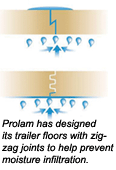
A competent trailer repair shop should be involved with any repair. Even then, repairs may still affect trailer warranties. So, it is always best to check with or maintain a relationship with an authorized dealer.
Wabash adds that a few common maintenance issues associated with roof systems include damaged roof bows and tears/punctures in the roof sheet. These issues can be minimized or avoided with proper specification.
Floor systems may have problems – such as cracked floor boards, broken floor fasteners and floor-board decay – caused by improper specification or improper use. Fortunately, these problems can all be reduced with the proper floor design and construction materials.

